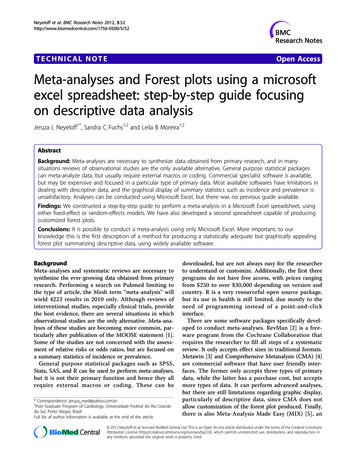
Transcription
ATHENA: A TOOL FOR META-DIMENSIONAL ANALYSIS APPLIED TOGENOTYPES AND GENE EXPRESSION DATA TO PREDICT HDL CHOLESTEROLLEVELSEMILY R. HOLZINGER†Center for Human Genetics Research, Vanderbilt UniversityNashville, TN 37232, USAEmail: emily.r.holzinger@vanderbilt.eduSCOTT M. DUDEKCenter for Systems Genomics, Pennsylvania State UniversityUniversity Park, PA 16803, USAEmail: sud23@psu.eduALEX T. FRASECenter for Systems Genomics, Pennsylvania State UniversityUniversity Park, PA 16803, USAEmail: alex.frase@psu.eduRONALD M. KRAUSSChildren’s Hospital Oakland Research InstituteOakland, CA 94609, USAEmail: rkrauss@chori.orgMARISA W. MEDINAChildren’s Hospital Oakland Research InstituteOakland, CA 94609, USAEmail: mwmedina@chori.orgMARYLYN D. RITCHIECenter for Systems Genomics, Pennsylvania State UniversityUniversity Park, PA 16803, USAEmail: marylyn.ritchie@psu.eduTechnology is driving the field of human genetics research with advances in techniques to generate high-throughputdata that interrogate various levels of biological regulation. With this massive amount of data comes the importanttask of using powerful bioinformatics techniques to sift through the noise to find true signals that predict varioushuman traits. A popular analytical method thus far has been the genome-wide association study (GWAS), whichassesses the association of single nucleotide polymorphisms (SNPs) with the trait of interest. Unfortunately, GWAShas not been able to explain a substantial proportion of the estimated heritability for most complex traits. Due to theinherently complex nature of biology, this phenomenon could be a factor of the simplistic study design. A morepowerful analysis may be a systems biology approach that integrates different types of data, or a meta-dimensionalanalysis. For this study we used the Analysis Tool for Heritable and Environmental Network Associations(ATHENA) to integrate high-throughput SNPs and gene expression variables (EVs) to predict high-density†Work supported by R01 LM010040, T32 GM080178, U01 HL065962 (P-STAR), U19 HL69757-10 (PARC)
lipoprotein cholesterol (HDL-C) levels. We generated multivariable models that consisted of SNPs only, EVs only,and SNPs EVs with testing r-squared values of 0.16, 0.11, and 0.18, respectively. Additionally, using just the SNPsand EVs from the best models, we generated a model with a testing r-squared of 0.32. A linear regression model withthe same variables resulted in an adjusted r-squared of 0.23. With this systems biology approach, we were able tointegrate different types of high-throughput data to generate meta-dimensional models that are predictive for the HDLC in our data set. Additionally, our modeling method was able to capture more of the HDL-C variation than a linearregression model that included the same variables.1. Introduction1.1. A Case for Meta-dimensional AnalysisOver the past decade, high-throughput technology has become considerably more efficient andless expensive1. The human genetics field has reaped the benefits of these advancements viaextensive exploratory analyses largely in the form of GWAS. These studies have led to thediscovery of thousands of SNPs that are significantly associated with hundreds of common,complex human traits2. However, for many of these traits, a large proportion of the estimatedheritability remains unexplained by these DNA variants3.One of the leading hypotheses regarding this “missing heritability” is that GWAS may not berobust to the inherent complexity of biological processes, and, therefore, may be missing largechunks of the underlying etiology4. Two areas where this complexity might lie are in non-additiveinteractions (gene-gene or gene-environment) and within the different levels of biologicalregulation. First, because traditional GWAS specifically identify SNPs with large main effects,interactions without large main effects would be missed. Next, complex phenotypes could beunder the influence of more than one level of biological regulation. Various types of –omic data(i.e. transcriptomic and methylomic) analyzed simultaneously could take into account traitvariation that would be missed by SNP data alone5. In order to account for complex etiology, amore powerful meta-dimensional analysis would have to be performed. A meta-dimensionalanalysis is one that integrates different types of high-throughput data while allowing for non-linearinteractions in order to identify multi-variable prediction models that include data from fromdifferent levels of biological regulation6. For example, analyzing microarray gene expression dataand SNP genotypes data simultaneously to identify models that predict a complex human disease,such as breast cancer.In order to successfully perform a meta-dimensional analysis, computational tools need to beable to perform the following tasks successfully: sift through the high level of noise inherent tohigh-throughput data in order to identify true signals, simultaneously analyze continuous andcategorical predictor and outcome variables, and identify main and interaction effects in order togenerate a final predictive model. Currently, no single analysis method performs all of these tasksat once. Some candidates that may come together to create a successful analysis pipeline includetree-based methods (i.e. Random Forests7), Bayesian networks, computational evolution methods,and various types of clustering and correlation techniques. For this paper, we propose a metadimensional analysis tool called ATHENA that combines a tree-based filtering method with acomputational evolution modeling method in order to integrate SNP genotypes and geneexpression variables to predict HDL-C levels.
1.2. The Genetics of HDL CholesterolHDL particles are small, dense lipoproteins that circulate throughout the body. Many antiatherogenic properties have been ascribed to HDL, and low HDL-C levels are strongly andindependently associated with increased risk for cardiovascular disease8. HDL-C has a relativelylarge genetic component with heritability estimates between 40-80%8,9. Many common variantshave been found to be significantly associated with HDL-C in humans, but collectively they onlyexplain a small proportion of the estimated heritability. A recent study used significant GWASSNPs to perform polygenic scoring and found that the best model only explained 4.75% of thevariation in the HDL-C trait10. Some groups have begun to examine a more complex geneticarchitecture to explain the missing heritability and several gene-gene interactions have beenidentified11–13. In this study, we aim to go a step further by integrating SNPs and gene expressiondata to find complex models that predict HDL-C levels.2. Methods2.1. The Analysis Tool for Heritable and Environmental Network Associations (ATHENA)ATHENA is a multi-functional software package designed by our lab to analyze various types ofhigh-throughput data in order to generate multi-variable models. ATHENA has been testedextensively on simulated data and applied to biological data sets in order to demonstrate its utilityon “noisy” data14–17. Figure 1 shows the full current and future functionality of ATHENA.Fig. 1. Components of the ATHENA software package
The main components of ATHENA are a filtering step and a modeling step. The filtering stepcan be a statistical filter (Random Jungle18) or one that prioritizes variables based on their knownbiological functions (Biofilter19). Currently, ATHENA has two different computational evolutionmodeling techniques--Grammatical Evolution Symbolic Regression (GESR) and GrammaticalEvolution Neural Networks (GENN). For this analysis, we used Random Jungle (RJ) as thestatistical filter and Grammatical Evolution Neural Networks (GENN) as the modeling technique.2.1.1. ATHENA filtering: Random JungleRJ is a faster, parallelized version of the tree-based variable selection method Random Forests(RF). Briefly, RF uses a bootstrap sample of the data to grow a “forest” of decision or regressiontrees with no pruning. The trees are then tested using the out-of-bag individuals not present in thebootstrap sample to determine which variables are most important for outcome prediction.Importantly, RF can identify main and interaction effects7. We chose RJ as the statistical filterbecause of its capability to analyze millions of quantitative and categorical variables in a relativelycomputationally efficient manner. Also, the output is a list of variables ranked by an importancescore. For this analysis, importance is defined as the percent increase in mean squared error afterpermuting the variable values while taking into account correlation patterns between thevariables20. This output lends itself nicely to selecting a subset of variables for input into amodeling technique that is less robust to noise.2.1.2. ATHENA modeling: Grammatical Evolution Neural NetworksGENN uses a variation of genetic programming (GP) called grammatical evolution (GE) tooptimize artificial neural networks to identify a model that predicts a given outcome21–23. GP is acomputational technique that uses concepts of survival of the fittest in order to evolve a fitsolution from an original population of random solutions24. GE is a more efficient version of GPbecause the solutions are represented as binary strings, which can be translated into a functionalsolution, or computer program, via grammar rules25. All of the evolutionary operations that areapplied to the solutions are done so at the level of the binary string. Below is the algorithm thatGENN uses to identify the “fittest” solution:1. Divide the data into five equal parts for cross-validation (4/5 training set; 1/5 testing set).2. Generate random sub-populations, or demes, of binary strings across multiple processors.3. Calculate the fitness (i.e. balanced accuracy or mean squared error) of the solutions using thetraining set.4. Select the solutions with the highest fitness, which undergo crossover, mutation, migrationbetween demes, and reproduction to create the next generation of solutions.5. Repeat Steps 3-4 for a user-defined number of generations.6. Test the final best model using the testing set and save the model.7. Repeat steps 2-6 for each the other four cross-validation data divisions.
8. Select the overall best model out of the five models using cross-validation consistency firstand then testing set fitness to break ties.The solutions in GENN are artificial neural networks (ANNs). Briefly, ANNs are directedgraphs with an input layer (independent variables), hidden layer(s) (processing elements), and anoutput layer that predicts the outcome of interest26. Figure 2 illustrates an example of a two-layerANN. ANNs are a good candidate for this type of analysis because they are able to modelcomplex, non-linear relationships between variables. Traditionally, ANNs are optimized using ahill-climbing algorithm, such as back-propagation, which iteratively alters the weights (orconstants) until prediction no longer improves23. This optimization technique is not ideal for agenetic analysis where the correct variables and the network architecture are not known a priori.GENN addresses this issue by evolving the ANNs so that the data drives the optimization of allaspects of the network. GENN has been tested on simulated and biological data and was oftenfound to outperform other prediction techniques16,22,27.Fig. 2. An example of a two-layer ANN. X input variable;w weight; AN activation node; y predicted output2.1.3. ATHENA filtering-modeling pipelineFigure 3 below summarizes the filtering-modeling pipeline that was used for this analysis.Fig. 3. ATHENA filtering-modeling pipeline for this analysis. Step 1. RJ filteringof SNPs and EVs; Step 2. GENN analysis of filtered SNPs only (2.1), EVs only(2.3) , and SNPs and EVs together (2.2); Step 3. GENN analysis of SNPs and EVsfrom the best GENN model from Steps 2.1 and 2.3.
In Step 1, we filtered the 2.7 million SNPs and 24,000 EVs separately in RJ. This was donebecause RJ has not been sufficiently tested to determine the effect of the overwhelmingly largernumber of SNPs versus EVs that were present in this data set ( 112x more SNPs). After filtering,we analyzed the filtered SNPs (Step 2.1), the filtered EVs (Step 2.3), and the filtered SNPs andEVs together (Step 2.2) in GENN. Because GENN has been shown to outperform other methodsspecifically at prediction modeling when the noise in the data is substantially reduced, we alsoassessed just the SNPs and EVs that were in the best ANN models from Steps 2.1 and 2.3 in afinal GENN analysis (Step 3).2.2. Cholesterol and Pharmacogenetics DatasetThe data for this study comes from the simvastatin clinical trial Cholesterol and Pharmacogenetics(CAP)28. The characteristics of the 480 individuals in this analysis are shown in Table 1. Thegenomic data consists of 2.7 million SNP genotype dosages and 24,000 gene expression levels.SNPs were genotyped on Illumina HumanHap 300K BeadChip and Illumina HumanHap 610Quad BeadChip and imputed to HapMap data using the IMPUTE2 software29. Imputationprobabilities were used to calculate genotype dosages. Gene expression levels were measured inpatient-derived immortalized lymphoblastoid cell lines (LCLs) using the Illumina HumanRef8v3BeadArray. The gene expression data was corrected for potential confounders by extracting theresiduals from a linear regression model that included known covariates (day of assay, cell count,gender, and age) and the top nine principal components for unknown covariates. Our outcome ofinterest was the mean HDL-C level from the first and follow-up visit before any medication wasadministered. HDL-C was adjusted for gender, age, body mass index (BMI), and smoking status.All of the individuals in this subset of the cohort were European-American.Table 1. Data set characteristicsClinical traitValueAge in years (mean [sd])54.4 [12.7]BMI (mean [sd])27.6 [5.3]HDL-C in mg/dl (mean [sd])53.4 [16.3]Smoker (% smoker)13.2Gender (% male)54.13. Results3.1. Random JungleTable 2 below lists the important parameter setting values that were used for RJ for each analysis.Table 2 also displays the computation times and the number of variables that remained afterbackward elimination. The values for bootstrap sample size and number of trees were previouslytuned for each data set as suggested by the method developers18.
Table 2. RJ filtering parameter settingsParameterEV analysisSNP analysisBootstrap Sample SizeNumber of TreesTree TypeImportance ScoreBackward EliminationNumber of ProcessorsCompute Time (hours)Remaining Variables112504000Regression treesPermutation-basedDiscard negative scores4 (500 trees / processor)0.614476843424032Regression treesPermutation-basedDiscard negative scores64 (63 trees / processor)52209346In order to have a comparable threshold for both data sets, we chose an importance scorecut-off because it has the same statistical meaning for both the SNPs and EVs. The threshold of10 was chosen because it generated similar distributions of scores in both data sets. This cut-offresulted in a filtered data set that consisted of 418 SNPs and 241 EVs.3.2. GENNThe filtered EV and SNP variables were analyzed both separately and simultaneously by GENN.In addition, the SNPs and EVs from the best GENN models were analyzed together. Table 3shows the GENN parameters that were used for these analyses. These parameters were selectedbased on a tuning analysis where we swept over various settings and selected based on predictionoptimization. A detailed description of the parameters can be found in a previous ATHENApublication14. The fitness function used by GENN for analysis of quantitative outcomes is shownbelow:(1)where y is the observed value, y-hat is the predicted value, and y-bar is the mean value for thequantitative outcome.Table 3. GENN parameter settingsParameterSteps 2.1, 2.3Steps 2.2, 3Number of demes (processors)Population Size / DemeNumber of generationsNumber of migrationsProbability of CrossoverProbability of MutationFitnessAnalysis time .90.01r-squared1
Figure 4 shows the resulting best ANN models from each of the following analyses: a.SNPs only (Step 2.1), b. EVs only (Step 2.3), and c. SNPs and EVs together (Step 2.2). The rsquared values from the testing cross-validation set for each of the models were 0.16, 0.11, and0.18, respectively.Fig. 4. Best GENN models from the a. SNP, b. EV, and c. SNP and EV integrated analyses. The asterisksin the integrated model denote variables that were present in at least one of the top five cross validationmodels from the separate SNP and EV analyses. (w constant and variable are multiplied; PADD additive activation node)Fig. 5. Best model GENN analysis of variables from best SNP andEV models. Testing r-squared value 0.32.
Finally, we ran GENN with only the 6 SNPs and 5 EVs that were present in the top modelsshown Figure 4a. and 4b. Figure 5 shows the resulting network from this analysis (Step 3). TheANN consisted of 3/6 SNPs and 4/5 EVs from the best models and the testing r-squared value was0.32. This is substantially greater than the three previous networks (Figure 4). Additionally, wetested the same variables using a more traditional statistical prediction method--multivariablelinear regression. The adjusted r-squared value from the regression model that included all 6SNPs and 5 expression variables was 0.23. The full regression model was highly significant, witha p-value of 2.2x10-16.4. DiscussionIn this study, we demonstrate a filtering-modeling pipeline for integrating different types of highthroughput data to generate meta-dimensional prediction models. We were able to build a modelthat includes variables from different levels of biological regulation and explained more variationthan either data-type alone (Figures 4 and 5). Additionally, our best model was more predictivethan the commonly used additive modeling technique. Due to its flexibility, this approach iseasily extendible to other types of high-throughput data. For example, another quantitative highthroughput measurement such as proteomic data could be added to this analysis by filtering thedata using the same RJ method and then adding in these filtered proteomic levels to the GENNanalysis.Notably, although the ANN from the integrated analysis had a higher r-squared value than theanalyses that only included SNPs or EVs (Figure 4), it was still less predictive than the analysisthat only included just the top SNPs and EVs (Figure 5). This could be a result of the combinedincrease in pressure on variable selection due to the larger number of predictor variables and onmodeling due to the different scales of the EV and SNP values. When we reduced the variableselection pressure by only including the top variables from the EV-only and SNP-only bestmodels, the r-squared value went up substantially. This highlights the ability of GENN to modelthe variables in an informative way when presented with a limited number of noise variables.Additionally, the GENN model was able to account for more outcome variation than the linearregression model indicating that the more complex modeling method of GENN identifiesrelationships between the variables that an additive model does not.One caveat to our approach is that we are not able to explore conditional relationships betweenthe different types of predictor variables. An example would be a model where a SNP in atranscription factor binding site reduces the expression of the targeted gene, which, in turn, affectsthe phenotype. These types of relationships could be tested by first examining significantcorrelations between SNPs and EVs and then using this information to guide the modelinganalysis. Also, some groups are applying Bayesian networks (BNs) to data integration studiesbecause they are able to capture this type of directionality30. Future work will involve
incorporating BNs into ATHENA as one of the analysis methods. Other study designs specificallyaddress the hypothesis that SNPs are affecting the phenotype via their association with geneexpression levels, such as eQTLs31–34. These studies have provided some interesting findings butwould not identify SNPs and EVs that have an effect on the phenotype independently of oneanother.Interpreting the biological significance of statistical models is not a trivial task for severalreasons. First, due the correlation patterns that exist in SNPs and EV data, the variables in the bestmodels could be functional variables or variables that are highly correlated with the functionalvariables. There is no simple way to determine which is the case. One initial approach could be tomap the top ranked SNPs and EVs back to genes to determine if the variables in the best modelsare representative of any given biological pathway or have similar biological function. Weassessed this possibility by analyzing the RJ filtered SNPs and EVs with an online annotation toolcalled DAVID35,36. The most significant biological groups after accounting for redundant pathwayinformation in the databases were those related to immune function. This is interesting becauseHDL has been shown to play a role in innate and adaptive immune responses37.Notably, we did not identify any of the genes known to be highly associated with HDL-C. Thegene that is arguably most strongly associated with HDL-C is CETP38,39. To determine if ourmethod was not able to find the effects or if the effects were simply not there, we performed aunivariate linear regression analysis on each of the SNPs and then ranked the p-values. None ofthe SNPs in CETP were significantly associated with HDL-C in our data set (data not shown).This suggests that in this subset of individuals, other genes could be more strongly contributing tothe variation in HDL-C.Once a meta-dimensional model has been identified and shown to be predictive, the next stepis to replicate the finding in an independent data set. For single SNPs, this process is relativelystraightforward. For meta-dimensional models, however, it becomes less trivial due to theincreased difficulty of replicating the exact effects of numerous data points simultaneously,especially if the identified variables are not completely correlated with the functional variants.One part of model validation will be to determine if the model is predictive in another data set.Additionally, the functionality of these genes could be tested in vitro or in vivo to determine ifperturbation has any phenotypic effect.The ultimate goal of identifying models that explain the genetic variability of a trait is to usethis information to improve therapy or prediction and prevention in a clinical setting. Methodsrobust to the true nature of complex traits, like the meta-dimensional analysis pipeline presentedhere, are an initial step towards a more thorough understanding of the genetic architecture ofcomplex human traits like cardiovascular disease.References1. Pareek, C. S., Smoczynski, R. & Tretyn, A. Sequencing technologies and genome sequencing. Journalof Applied Genetics 52, 413–435 (2011).2. Hindorff, L. A. et al. Potential etiologic and functional implications of genome-wide association locifor human diseases and traits. Proc. Natl. Acad. Sci. U.S.A. 106, 9362–9367 (2009).
3. Visscher, P. M., Brown, M. A., McCarthy, M. I. & Yang, J. Five years of GWAS discovery. Am. J.Hum. Genet. 90, 7–24 (2012).4. Maher, B. Personal genomes: The case of the missing heritability. Nature 456, 18–21 (2008).5. Reif, D. M., White, B. C. & Moore, J. H. Integrated analysis of genetic, genomic and proteomic data.Expert.Rev Proteomics. 1, 67–75 (2004).6. Holzinger, E. R. & Ritchie, M. D. Integrating heterogeneous high-throughput data for metadimensional pharmacogenomics and disease-related studies. Pharmacogenomics 13, 213–222 (2012).7. Breiman, L. Random Forests. Machine Learning 45, 5–32 (2001).8. Boes, E., Coassin, S., Kollerits, B., Heid, I. M. & Kronenberg, F. Genetic-epidemiological evidence ongenes associated with HDL cholesterol levels: A systematic in-depth review. ExperimentalGerontology 44, 136–160 (2009).9. Weissglas-Volkov, D. & Pajukanta, P. Genetic causes of high and low serum HDL-cholesterol. TheJournal of Lipid Research 51, 2032–2057 (2010).10. Demirkan, A. et al. Genetic architecture of circulating lipid levels. European Journal of HumanGenetics 19, 813–819 (2011).11. Turner, S. D. et al. Knowledge-driven multi-locus analysis reveals gene-gene interactions influencingHDL cholesterol level in two independent EMR-linked biobanks. PLoS ONE 6, e19586 (2011).12. Ma, L. et al. Knowledge-driven analysis identifies a gene-gene interaction affecting high-densitylipoprotein cholesterol levels in multi-ethnic populations. PLoS Genet. 8, e1002714 (2012).13. He, J. et al. Gene-based interaction analysis by incorporating external linkage disequilibriuminformation. Eur. J. Hum. Genet. 19, 164–172 (2011).14. Holzinger, E. R. et al. Initialization Parameter Sweep in ATHENA: Optimizing Neural Networks forDetecting Gene-Gene Interactions in the Presence of Small Main Effects. Genet Evol Comput Conf. 12,203–210 (2010).15. Holzinger, E. R., Dudek, S. M., Torstenson, E. C. & Ritchie, M. D. ATHENA Optimization: TheEffect of Initial Parameter Settings Across Different Genetic Models. Lect Notes Comput Sci 6623, 48–58 (2011).16. Holzinger, E. R. et al. Comparison of Methods for Meta-dimensional Data Analysis Using in Silicoand Biological Data Sets. Evolutionary Computation, Machine Learning and Data Mining inBioinformatics 7246, 134–143 (2012).17. Turner, S. D., Dudek, S. M. & Ritchie, M. D. ATHENA: A knowledge-based hybrid backpropagationgrammatical evolution neural network algorithm for discovering epistasis among quantitative traitLoci. BioData.Min 3, 5 (2010).18. Schwarz, D. F., Konig, I. R. & Ziegler, A. On safari to Random Jungle: a fast implementation ofRandom Forests for high-dimensional data. Bioinformatics 26, 1752–1758 (2010).19. Bush, W. S., Dudek, S. M. & Ritchie, M. D. Biofilter: A knowledge-integration system for the multilocus analysis of genome-wide association studies. Pac Symp Biocomput In review, (2009).20. Meng, Y. A., Yu, Y., Cupples, L. A., Farrer, L. A. & Lunetta, K. L. Performance of random forestwhen SNPs are in linkage disequilibrium. BMC Bioinformatics 10, 78 (2009).21. Motsinger-Reif, A. A., Dudek, S. M., Hahn, L. W. & Ritchie, M. D. Comparison of approaches formachine-learning optimization of neural networks for detecting gene-gene interactions in geneticepidemiology. Genet Epidemiol 32, 325–340 (2008).22. Motsinger-Reif, A. A., Fanelli, T. J., Davis, A. C. & Ritchie, M. D. Power of grammatical evolutionneural networks to detect gene-gene interactions in the presence of error. BMC.Res.Notes 1, 65 (2008).23. Motsinger-Reif, A. A. & Ritchie, M. D. Neural networks for genetic epidemiology: past, present, andfuture. BioData.Min 1, 3 (2008).24. Koza, J. Genetic Programmming. (MIT Press: Cambridge, Massachusetts, 1993).25. O’Neill, M. & Ryan, C. Grammatical Evolution. IEEE Transactions on Evolutionary Computation 5,(2001).
26. Anderson, J. A. An Introduction to Neural Networks. (MIT Press: Cambridge, Massachusetts, 1995).27. Spencer, K. L. et al. Using genetic variation and environmental risk factor data to identify individualsat high risk for age-related macular degeneration. PLoS.One. 6, e17784 (2011).28. Simon, J. A. et al. Phenotypic predictors of response to simvastatin therapy among African-Americansand Caucasians: the Cholesterol and Pharmacogenetics (CAP) Study. Am J Cardiol 97, 843–850(2006).29. Howie, B. N., Donnelly, P. & Marchini, J. A Flexible and Accurate Genotype Imputation Method forthe Next Generation of Genome-Wide Association Studies. PLoS Genetics 5, e1000529 (2009).30. Fridley, B. L., Lund, S., Jenkins, G. D. & Wang, L. A Bayesian integrative genomic model for pathwayanalysis of complex traits. Genet. Epidemiol. 36, 352–359 (2012).31. Huang, R. S. et al. A genome-wide approach to identify genetic variants that contribute to etoposideinduced cytotoxicity. Proc Natl Acad Sci U S A 104, 9758–9763 (2007).32. Huang, R. S. et al. Genetic variants contributing to daunorubicin-induced cytotoxicity. Cancer Res 68,3161–3168 (2008).33. Huang, R. S., Duan, S., Kistner, E. O., Hartford, C. M. & Dolan, M. E. Genetic variants associatedwith carboplatin-induced cytotoxicity in cell lines derived from Africans. Mol Cancer Ther 7, 3038–3046 (2008).34. Huang, R. S. et al. Identification of genetic variants contributing to cisplatin-induced cytotoxicity byuse of a genomewide approach. Am J Hum Genet 81, 427–437 (2007).35. Huang, D. W., Sherman, B. T. & Lempicki, R. A. Bioinformatics enrichment tools: paths toward thecomprehensive functional analysis of large gene lists. Nucleic Acids Res. 37, 1–13 (2009).36. Huang, D. W., Sherman, B. T. & Lempicki, R. A. Systematic and integrative analysis of large genelists using DAVID bioinformatics resources. Nat Protoc 4, 44–57 (2009).37. Norata, G. D., Pirillo, A., Ammirati, E. & Catapano, A. L. Emerging role of high density lipoproteinsas a player in the immune system. Atherosclerosis 220, 11–21 (2012).38. Teslovich, T. M. et al. Biological, clinical and population relevance of 95 loci for blood lipids. Nature466, 707–713 (2010).39. Dullaart, R. P. F. & Sluiter, W. J. Common variation in the CETP gene and the implications forcardiovascular disease and its treatment: an updated analysis. Pharmacogenomics 9, 747–763 (2008).
integrate different types of high-throughput data to generate meta-dimensional models that are predictive for the HDL-C in our data set. Additionally, our modeling method was able to capture more of the HDL-C variation than a linear regression model that included the same variables. 1. Introduction 1.1. A Case for Meta-dimensional Analysis










